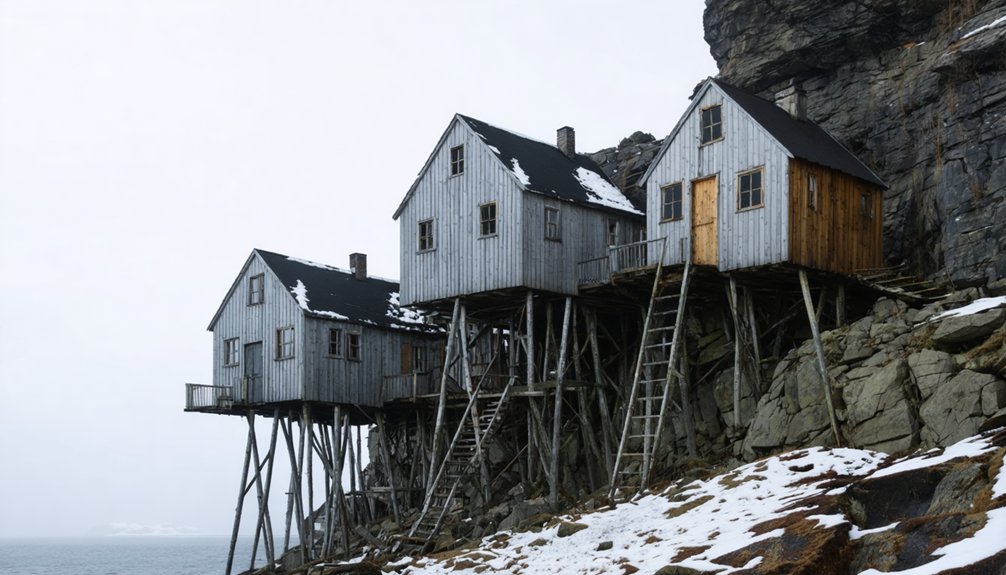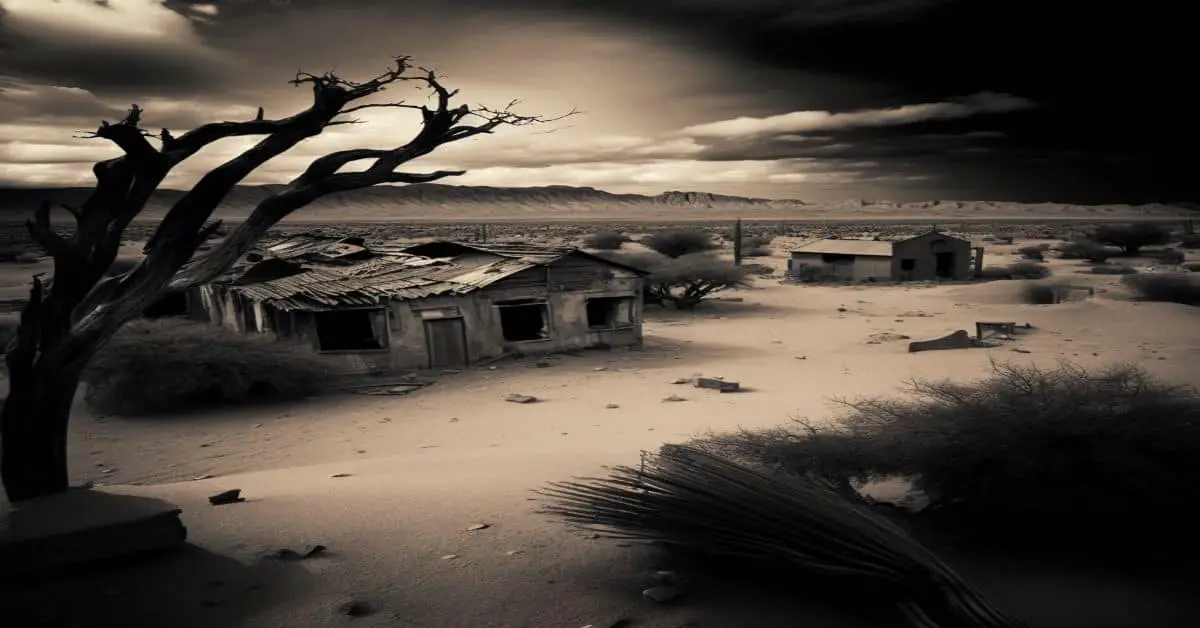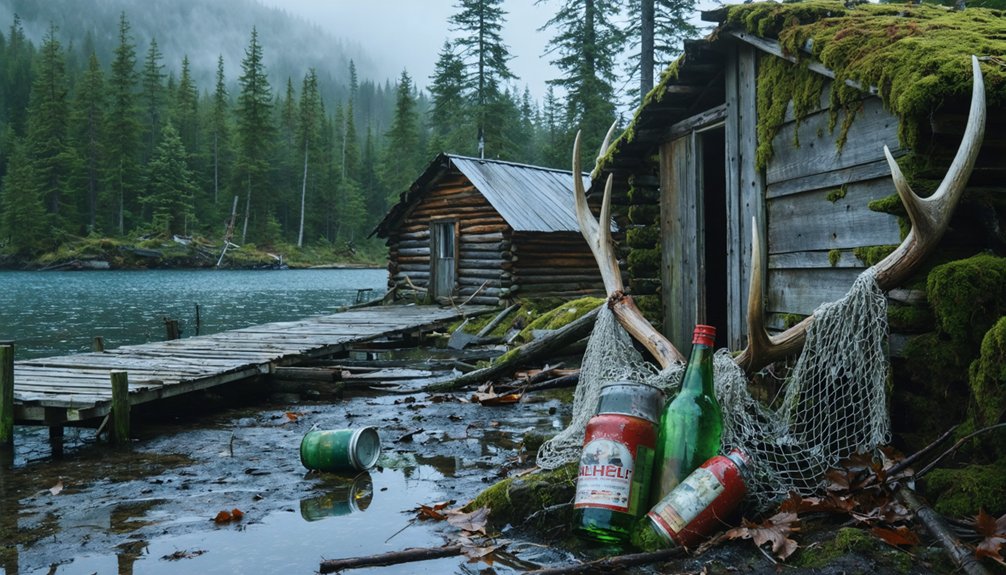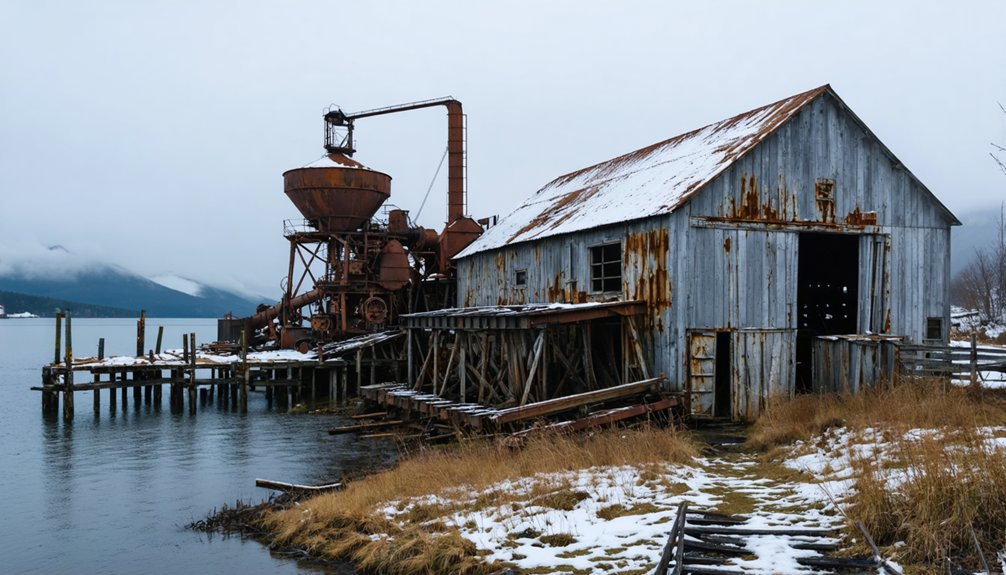You’ll find Ukivok’s abandoned stilt houses clinging to 45-degree cliffs on Alaska’s King Island, 86 miles from Nome. This former Inupiat settlement showcases remarkable indigenous engineering, with wooden homes built to withstand harsh Bering Sea conditions while maximizing limited space on the steep terrain. The community thrived until 1959 when the Bureau of Indian Affairs closed the local school, leading to complete abandonment by 1970. The silent structures hold countless stories of the Aseuluk people’s resilient past.
Key Takeaways
- Ukivok was an Inupiat settlement on Alaska’s King Island, built on 45-degree cliff slopes with distinctive wooden houses on stilts.
- The settlement became a ghost town by 1970 after the Bureau of Indian Affairs closed the local school in 1959.
- Residents practiced traditional hunting of seals, walruses, and whales, with community life centered around their gathering house called Qagri.
- The abandoned stilt houses remain as deteriorating remnants, showcasing indigenous engineering adapted to harsh Arctic coastal conditions.
- Access to Ukivok is challenging due to steep rocky cliffs, slippery conditions, and an elevation gain of 1,000 feet.
A Cliffside Village in the Bering Sea
Perched precariously on the cliffs of Uġiuvak Island, Ukivok stands as one of Alaska’s most remarkable abandoned settlements.
Like an eagle’s nest frozen in time, Ukivok clings to Alaska’s rugged cliffs, a testament to human perseverance.
You’ll find this remote village 86 miles from Nome, clinging to a 45-degree slope on an island that’s barely 1.5 miles across. The cliff side architecture showcases an ingenious adaptation to the harsh environment, with wooden structures balanced on stilts and connected by elevated pathways.
The island’s ecology reflects its austere nature, dominated by steep rock faces and lacking natural beaches. Early inhabitants relied on walrus and seal hunting for subsistence in this challenging environment. The island is a vital sanctuary for eleven bird species, hosting approximately 250,000 birds in total.
You’re looking at a geological marvel – a pluton formed over 85 million years ago, composed of quartz monzonites that create the island’s dramatic double-peaked profile. The rugged terrain and isolation made this one of the Arctic’s most challenging locations for year-round habitation.
Life Among the Aseuluk People
You’ll find the Aseuluk people were masterful hunters who tracked seals, walruses, and crabs while gathering bird eggs to sustain their families throughout the year.
During the long winter months, you’d witness their vibrant community life centered around the Qagri, where traditional dances and celebrations brought warmth to the cold season. Their commitment to oral history traditions ensured cultural knowledge was passed down through generations of storytelling.
Extended family groups worked together in close-knit units, with experienced hunters teaching younger generations the skills needed for survival on King Island’s challenging terrain. The forced relocation policies during World War II permanently disrupted this traditional way of life.
Daily Hunting and Gathering
The Aseuluk people of Ukivok sustained themselves through an intricate system of hunting and gathering that centered on marine mammals, particularly walrus, seals, and small whales.
You’d find them practicing sustainable techniques that varied with the seasons, from ice-hole seal hunting in winter to shoreline harvests in summer.
During the warmer months, you could spot families gathering berries, edible greens, and seabird eggs to supplement their protein-rich diet.
Their seasonal migrations took them to mainland areas near Nome, where they’d expand their foraging options and engage in trade.
They’d craft specialized tools from walrus ivory and caribou bones, while using seal and walrus hides to construct their boats (umiaq).
Every part of their catch served a purpose – from meat for food to blubber for oil lamps.
Elders played a vital role in passing down traditional hunting knowledge to younger generations, ensuring the survival of crucial subsistence practices.
Like many North Slope communities, they celebrated successful hunts with feasts that strengthened social bonds and community unity.
Qagri Winter Celebrations
During the darkest winter months, when daylight dwindled to just four hours, Ukivok’s Qagri became the heart of Aseuluk social and spiritual life.
In this men’s communal house, you’d witness powerful ancestral rituals and communal dances, especially during Sautugvik – the “time of drumming” in December. Dancers in traditional regalia would move to rhythmic beats, invoking spirits and celebrating community resilience. Like the time for sharing food during Quviasukvik, these gatherings helped ensure everyone’s survival through difficult winters. The gift exchange ceremonies honored the goddess Sedna and brought hopes of good fortune for the coming year.
Qagri gatherings strengthened village bonds through storytelling, ceremonial feasts, and intergenerational teaching.
You’d see elders passing down oral traditions while sharing meals of stored marine mammals and birds. Winter feasting reflected status and reinforced reciprocity among villagers.
Through strict spiritual observances and symbolic acts like ceremonial fire-lighting, the Aseuluk maintained harmony with both the spirit world and their isolated community.
Traditional Family Structures
While living in their cliffside homes on King Island, Aseuluk families maintained intricate social structures that prioritized extended kinship ties and collective survival.
You’d find multiple generations sharing living spaces, with family roles carefully distributed to guarantee the community’s sustenance. Men took charge of dangerous marine mammal hunting, while women and children focused on food processing and egg gathering. The community would often gather in the traditional Qagri building to share stories and perform ceremonial dances during the long winter months.
Strong kinship bonds formed the foundation of daily life, as extended families shared everything from childcare duties to food resources. You couldn’t survive the harsh winters alone – it took the combined effort of every family member working together. The island’s population of two hundred people remained stable for centuries through these cooperative family arrangements.
Decisions about hunting, harvesting, and resource distribution weren’t made individually but through collective family discussions, with respected elders offering essential guidance for the community’s wellbeing.
Engineering Marvel: Houses on Stilts
Rising from King Island’s steep cliffs, Ukivok’s remarkable stilt houses stand as evidence of indigenous engineering ingenuity.
You’ll find these wooden dwellings perched on tall stilts extending from rocky slopes with inclines up to 45°, an architectural adaptation born from necessity. The Aseuluk people created this innovative stilt construction system to overcome the island’s lack of flat, sheltered ground.
The engineering marvel lies in how these structures were secured to the uneven terrain. Using wood sourced from driftwood or mainland Alaska, builders created stable platforms that could withstand harsh coastal conditions while protecting homes from flooding and sea spray.
The design maximized limited space through terraced rows of houses, transforming an seemingly uninhabitable landscape into a thriving community that lasted until 1970.
The Rise and Fall of Whaling
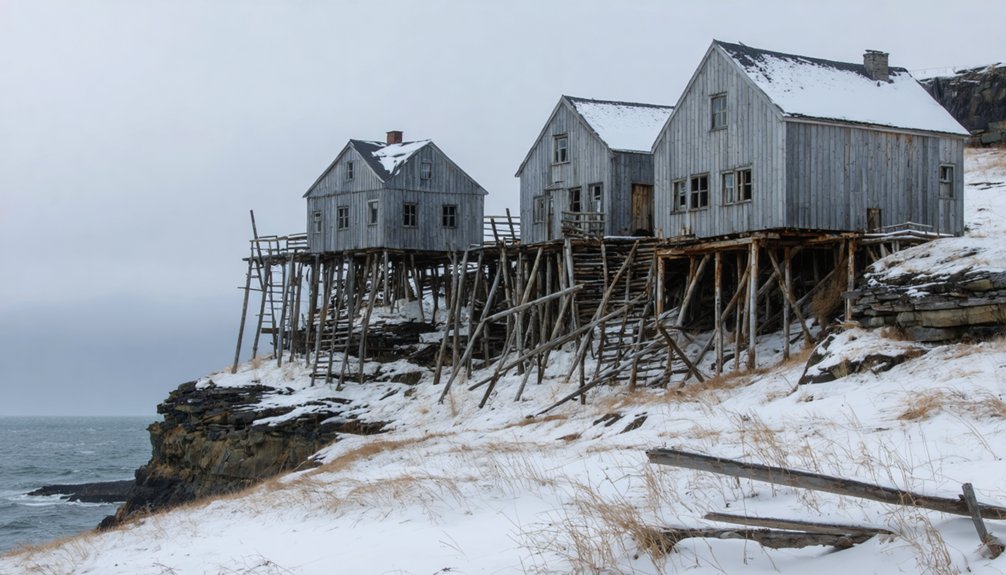
For centuries, the Ugiuvaŋmiut people of King Island mastered the art of subsistence whaling, expertly maneuvering treacherous Arctic waters in skin-covered umiaks to hunt bowhead whales. Their whaling techniques integrated seamlessly with other seasonal activities like seal hunting and fishing, forming the backbone of their survival strategy.
However, you’ll find that everything changed when Russian and American commercial whalers arrived in the late 1800s. Their mass exploitation of marine resources devastated the indigenous food supply, leading to the deaths of over 200 Ugiuvaŋmiut in 1890.
The cultural significance of whaling endured, though communities were forced to adapt. While regulated subsistence whaling continues today among Inupiat and Yupik peoples, King Island’s whaling tradition effectively ended when the BIA’s closure of the local school triggered a permanent exodus to mainland Alaska.
Abandonment and Modern Ghost Town
You’ll find that Ukivok’s forced exodus began in 1959 when the Bureau of Indian Affairs closed the island’s only school, compelling families to relocate their children to mainland schools.
The final permanent residents departed by the early 1970s, marking the end of year-round habitation that had sustained the Inupiat community for generations.
Today, dozens of wooden stilt houses remain perched on the steep cliffs, creating an eerie time capsule where personal belongings can still be found inside the abandoned structures.
Forced Exodus Timeline
Once a thriving community of 200 Iñupiat residents, Ukivok faced a turning point in the mid-1900s when the Bureau of Indian Affairs closed the local school, forcing children to attend mainland institutions year-round.
This historical policy disrupted the community’s traditional lifestyle, as younger members could no longer assist with vital winter food gathering.
The resulting strain on food security and community cohesion triggered a gradual indigenous migration toward mainland settlements, particularly Nome.
By 1970, you’d find Ukivok completely deserted, its distinctive stilt houses standing empty against the cliff face.
While the structures remain mostly intact today, they serve as silent witnesses to forced relocation.
Since the early 2000s, you’ll see occasional returns to the island, primarily through research-funded cultural reconnection projects.
Empty Structures Remain Standing
The abandoned homes of Ukivok cling precariously to King Island’s cliff face, their weathered wooden frames perched on stilts at a steep 45-degree angle.
You’ll find these remarkable structures, designed to withstand brutal Bering Sea storms, now slowly surrendering to nature’s relentless forces. The buildings hold immense cultural significance as monuments to Inupiat ingenuity, with their unique architectural solutions perfectly adapted to this harsh environment.
Time stands still within these empty dwellings, where doorways and window frames remain as silent witnesses to a displaced community.
The ecological impact of weather exposure continues to decay the wooden walls and floors, yet the village’s remote location and difficult access have paradoxically helped preserve it.
While cruise ships occasionally pass by, you’ll need special permits from the King Island Native Community to visit these haunting remnants of indigenous life.
Preserving Cultural Heritage
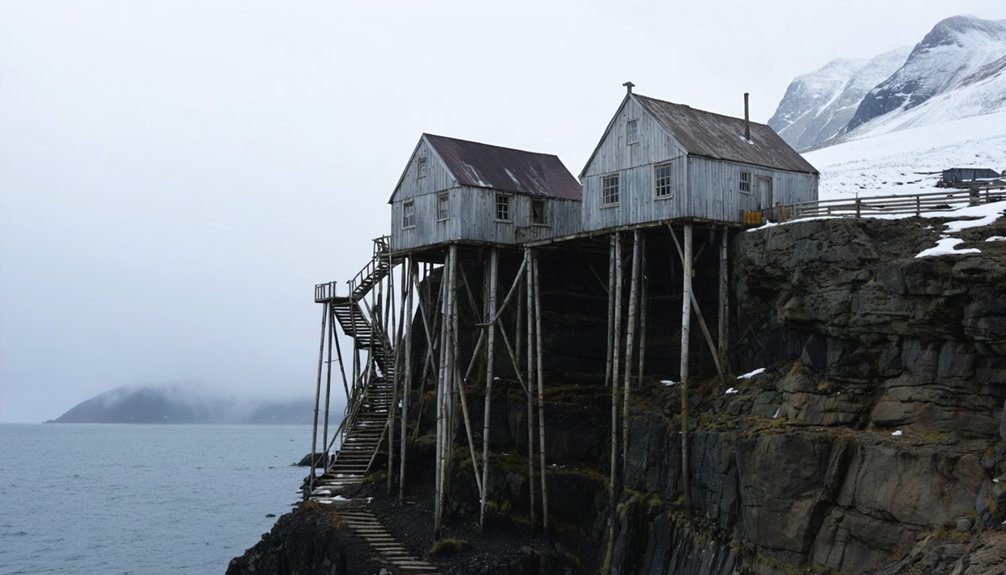
While Ukivok’s physical structures stand as silent witnesses to history, preserving its rich cultural heritage involves far more than protecting abandoned buildings.
The Aseuluk people’s cultural significance is woven into every aspect of the settlement, from their sophisticated stilt houses to their deep connection with marine resources. You’ll find evidence of their remarkable adaptation to Arctic life through seasonal hunting patterns and communal traditions centered around the qagri.
Heritage preservation efforts now focus on documenting oral histories from former residents and their descendants, ensuring that traditional knowledge isn’t lost.
Local researchers facilitate visits for community members to reconnect with their ancestral lands, while interpretative programs help share the story of this remarkable settlement.
Despite challenges of accessibility and harsh weather, these initiatives keep Ukivok’s legacy alive for future generations.
Beyond the cultural significance of Ukivok lies King Island’s formidable physical landscape, which presents unique challenges for modern-day visitors and researchers.
You’ll encounter steep rocky cliffs on all sides of this 1.7-mile-long island, with terrain challenges that demand careful navigation techniques.
The island’s biotite-hornblende quartz monzonite composition creates treacherous conditions, especially when combined with slippery algae and loose boulders.
Beware the deceptive terrain where biotite-hornblende quartz monzonite meets marine growth, creating a precarious dance between rock and slime.
You’ll need to navigate an elevation gain of approximately 1,000 feet while dealing with harsh marine conditions and severe storms.
If you’re planning to explore by sea, you’ll require specialized vessels and extensive local knowledge to safely approach the island.
The steep slopes and exposure to elements make foot travel particularly demanding, requiring strategic route planning and proper safety equipment.
Frequently Asked Questions
What Traditional Medicine and Healing Practices Did the Aseuluk People Use?
You’ll find they used herbal remedies from native plants, spiritual healing through prayer and song, seal oil treatments, wild berry medicines, and healing circles to maintain harmony with nature.
How Did Villagers Handle Waste Disposal and Sanitation on the Cliffs?
You’d handle waste management by utilizing the cliff’s natural drop, directing waste over edges or beneath stilt houses. Sanitation practices relied on sea currents and seasonal migration to limit waste accumulation.
What Games and Recreational Activities Were Popular Among Ukivok Children?
You’d join hunting simulations, play tag on walkways, enjoy sledding games between cliff homes, compete in fishing activities, and participate in drum dancing and cultural performances with other children.
Were There Any Documented Supernatural Beliefs or Legends About King Island?
While you’ll find creation myths about King Island’s formation from a giant fish, there’s no evidence of traditional supernatural legends or ghost stories in documented indigenous beliefs about the island.
How Did the Villagers Store and Preserve Food During Harsh Winters?
You’d store food by freezing it naturally in winter ice, while also using traditional preservation methods like drying and fermenting. During summer, you’d gather provisions and share them communally for winter storage.
References
- https://www.islands.com/1931925/king-island-ukivok-alaska-forgotten-coastal-village-stilts-remote-wonder-stories-vanished-era/
- https://www.atlasobscura.com/places/ukivok
- https://www.alaska-stories.com/p/the-fascinating-surprising-king-island
- https://www.sensesatlas.com/ukivok-island-the-ghost-village-on-stilts/
- https://www.messynessychic.com/2016/11/01/alaskas-eskimo-ghost-village-on-stilts/
- https://en.wikipedia.org/wiki/King_Island_(Alaska)
- https://www.youtube.com/watch?v=B-9OGe-0LRI
- https://substack.com/@shehikesalaska/note/p-176298580?r=5d3k02
- https://coastview.org/2025/08/11/king-island-village-bering-sea/
- https://furillendotorg.wordpress.com/ukivok/
